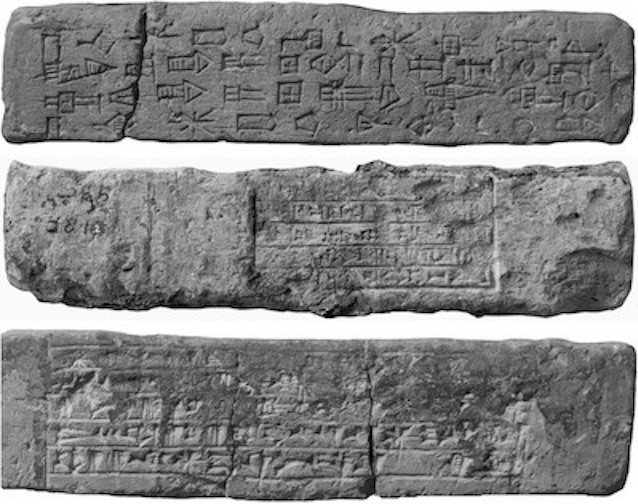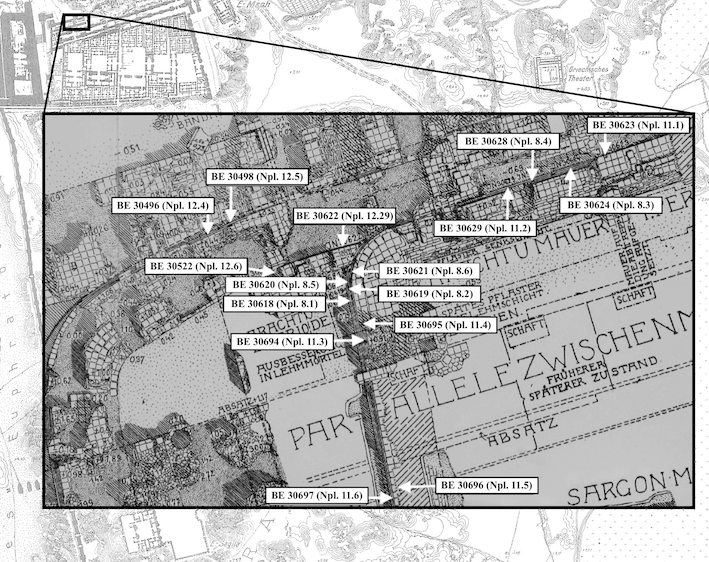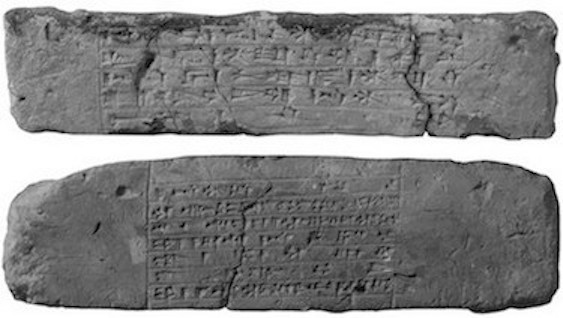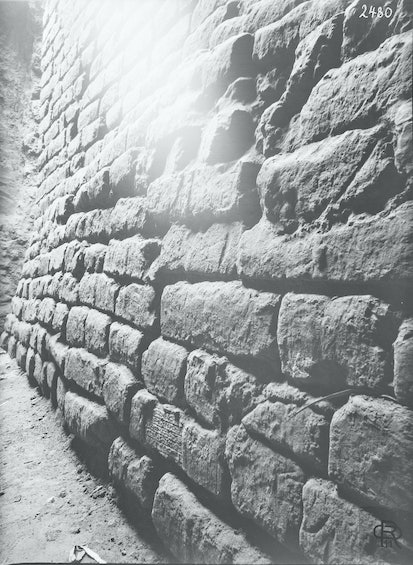Inscriptions of Nabopolassar from Babylon
Jump to Nabopolassar 8 Nabopolassar 9 Nabopolassar 10 Nabopolassar 11 Nabopolassar 12 Nabopolassar 13
Five of the six known brick inscriptions of Nabopolassar from Babylon deal with his work on the embankment wall (kār agurri) or the embankment wall of the Araḫtu River (kār Araḫti). Npl. 8–10 are often referred to as the "Embankment Inscriptions" (Versions 1–3) since they state that Nabopolassar surrounded the wall(s) of (the inner city of) Babylon with a kār agurri ("an embankment of baked bricks"), while Npl. 11–12 are generally called the "Araḫtu Inscriptions" (Versions 1–2) because the king calls himself ēpiš kār Araḫti ana Marduk bēlīšu ("the one who built the embankment of the Araḫtu River for the god Marduk, his lord"). The inscriptions, which are often placed near one another (see Fig. 12) in the same part(s) of the wall, are inscribed (Npl. 9–10 and 12), carved (Npl. 8), and stamped (Npl. 11) on the edges of the bricks (for example, see Fig. 13). The order of Nabopolassar's brick inscriptions presented here follows that of Da Riva, SANER 3.
Several bricks discovered during Koldewey's excavations of the Kasr at Babylon bear a four-line Akkadian inscription of Nabopolassar stating that he reinforced Babylon's embankment wall with baked bricks. The text, which has been carved into the edge of each brick, is written in an archaizing Neo-Babylonian script; see Fig. 11. This inscription is sometimes referred to as "Nabopolassar Brick B I, 1" or "[Nabopolassar] Embankment Inscription, Version 1 (B1)."

VA Bab 4383 (Npl. 8 ex. 3), VA Bab 4081 (Npl. 11 ex. 8), and VA Bab 4384 (Npl. 12 ex. 12), three bricks of Nabopolassar mentioning his work on Babylon's embankment walls. © Staatliche Museen zu Berlin – Vorderasiatisches Museum. Photo: Olaf M. Teßmer.
Access Nabopolassar 8 [ /ribo/babylon7/Q005367/].
Sources
| (1) EŞ (BE 30618) | (2) BE 30619 |
| (3) VA Bab 4383 (BE 30624) | (4) BE 30628 |
| (5) BE 30620 | (6) BE 30622 |
Commentary
The master text is a conflation of exs. 1 (BE 30618) and 3 (BE 30624; VA Bab 4383). The lineation is marginally different across the known exemplars of this short Akkadian inscription. The present edition uses the distribution of the text in ex. 1. No horizontal rulings are carved between the lines of text. Following RINBE editorial practices, no score of this brick inscription is given on Oracc. The minor (orthographic) variants, however, are given in the critical apparatus at the back of the book.
Bibliography

Plan of Babylon, with a detailed view of a section of the embankment wall of the Araḫtu River (phases 1–3) north of the South Palace showing the find spots of sixteen inscribed, carved, and stamped bricks of Nabopolassar (Npl. 8 and 11–12). Adapted from Wetzel, Stadtmauern pl. 11.
Numerous bricks excavated by R. Koldewey at Babylon bear the same short, eighteen-word Akkadian inscription of Nabopolassar recording that he had an embankment wall of baked bricks constructed outside Babylon's city wall(s). This text, which is a shorter version of the following inscription (Npl. 10 [B5]), is inscribed on the edges of the bricks. On two exemplars, the script is contemporary Neo-Babylonian, while, on at least nine exemplars, it is archaizing Neo-Babylonian. In previous studies and editions, the inscription is referred to as "Nabopolassar Brick B I, 3" or "[Nabopolassar] Embankment Inscription, Version 2 (B3)."
Access Nabopolassar 9 [ /ribo/babylon7/Q005368/].
Sources
| (1) VA Bab 4055 (BE 58157) | (2) VA Bab 4055 (BE 55758) |
| (3) BE 56769 | (4) BE 56770 |
| (5) VA Bab 4055 (BE 56772) | (6) EŞ 9050 (BE 56773) |
| (7) BE 56774 | (8) BE 60751 |
| (9) BE 58150 | (10) EŞ 9049 (BE 58151) |
| (11) BE 58152 | (12) VA Bab 4055 (BE 59733) |
| (13) VA Bab 4055 (BE 59734) | (14) BE 59735 |
| (15) BE 59736 | (16) BE 58911 |
| (17) BE 59771 | (18) BE 59772 |
| (1*) | (2*) |
| (3*) |
Commentary
PExs. 1 and 7 are written in contemporary Neo-Babylonian script, while exs. 2–6 and 8–11 are written in archaizing Neo-Babylonian script; it is presently not known which script(s) was (were) used to write out exs. 12–3* since those exemplars were not available for study. The number of lines over which the text is distributed ranges from four to six lines on different exemplars: exs. 1, 13, and 15 are inscribed in four lines; exs. 2–8, 12, 14, and 16 in five lines; and exs. 9–11 and 17–18 in six lines. Horizontal rulings separate each line of text.
Exs. 16–18 are regarded as certain exemplars of this inscription since they are written in five and six lines of text; note that all of the known exemplars of Npl. 10 (B5) have seven lines of text. Exs. 1*–3* — which are known only from notations ("Sch.Z") on Wetzel, Stadtmauern pl. 25 — are provisionally included as possible exemplars of this inscription based on their provenance and on the fact that they are reported to have been inscribed (rather than stamped). Since the contents of the bricks, the script, and lineation could not be confirmed, these three bricks have been tentatively included as uncertain, rather than as certain, exemplars of 'Version 2' of the Embankment Inscription.
The master text is a conflation of exs. 1–2, 4, and 10–11. The lineation, however, follows ex. 1. Following RINBE editorial practices, no score of this brick inscription is given on Oracc. Moreover, no minor (orthographic) variants are given in the critical apparatus at the back of the book. As mentioned above, this inscription (B3) duplicates Npl. 10 (B5), but with the omission ti-ri-iṣ ŠU.II dAG ù dAMAR.UTU, "protégé of the gods Nabû and Marduk."
Bibliography

VA Bab 4055 (Npl. 9 ex. 5) and VA Bab 4382 (BE 58130; Npl. 10 ex. 1), two bricks of Nabopolassar recording his work on the embankment walls. © Staatliche Museen zu Berlin – Vorderasiatisches Museum. Photo: Olaf M. Teßmer.
At least thirty-one bricks from Babylon bear a third inscription of Nabopolassar stating that he built an embankment wall around Babylon; the script is archaizing Neo-Babylonian. This near duplicate of Npl. 9 (B3) is occasionally called "Nabopolassar Brick B I, 5" or "[Nabopolassar] Embankment Inscription, Version 3 (B5)" in previous studies and editions.
Access Nabopolassar 10 [ /ribo/babylon7/Q005369/].
Sources
| (1) VA Bab 4382 (BE 58130) | (2) BE 56413 |
| (3) VA Bab 4057 (BE 56414) | (4) VA Bab 4057 (BE 56472) |
| (5) VA Bab 4057 (BE 56473) | (6) VA Bab 4057 (BE 56474) |
| (7) VA Bab 4057 (BE 56475) | (8) VA Bab 4057 (BE 56511) |
| (9) EŞ 9100 (BE 56512) | (10) VA Bab 4057 (BE 56513) |
| (11) VA Bab 4057 (BE 56514) | (12) BE 57299 |
| (13) VA Bab 4057 (BE 58129) | (14) EŞ 9102 (BE 58131) |
| (15) VA Bab 4057 (BE 58132) | (16) VA Bab 4057 (BE 58133) |
| (17) EŞ 9092 (BE 58134) | (18) VA Bab 4057 (BE 58135) |
| (19) VA Bab 4057 (BE 58136) | (20) IM — (BE 58137) |
| (21) VA Bab 4057(BE 58138) | (22)VA Bab 4057 (BE 58139) |
| (23) VA Bab 4057(BE 58140) | (24)VA Bab 4057 (BE 58141) |
| (25) VA Bab 4057(BE 58142) | (26)IM — (BE 58143) |
| (27) VA Bab 4057(BE 58144) | (28)BE 58145 |
| (29) BE 58146 | (30)VA Bab 4057 (BE 58147) |
| (31) IM — (BE 58148) |
Commentary
pContrary to Da Riva, SANER 3 p. 36, there are thirty-one, not forty-one, exemplars of this brick inscription of Nabopolassar. All 'ten exemplars' of her 'ex. 1' should be subsumed under the 'thirty-one exemplars' of her 'ex. 2' since those ten bricks have been double counted; for example, VA Bab 4382 is BE 58130. Twenty-two, not ten, of the thirty-one bricks are housed in the Vorderasiatisches Museum (Berlin; exs. 1, 3–8, 10–11, 13, 15–16, 18–19, 21–25, 27, and 30); all but one of those bricks have been assigned the museum number VA Bab 4057.
The master text is a conflation of several exemplars, but with preference given to ex. 1 (VA Bab 4382; BE 58130). The script in all instances is archaizing Neo-Babylonian. All of the known exemplars distribute this twenty-three-word Akkadian inscription over seven lines, with horizontal rulings separating each line of text. Following RINBE editorial practices, no score of this brick inscription is given on Oracc. The minor (orthographic) variants, however, are given in the critical apparatus at the back of the book.
Bibliography
A five-line Akkadian inscription of this Neo-Babylonian king mentioning his work on the Araḫtu River is stamped in archaizing Neo-Babylonian script on at least twelve bricks discovered at Babylon. This shorter version of Npl. 12 (B4) is sometimes referred to as "Nabopolassar Brick B I, 2" or "[Nabopolassar] Araḫtu Inscription, Version 1 (B2)." Unlike the other known Babylon bricks of Nabopolassar, this text does not have a petition to the quay wall to speak favorable things to the god Marduk.
Access Nabopolassar 11 [ /ribo/babylon7/Q005370/].
Sources
| (1) EŞ 9101 (BE 30623) | (2) BE 30629 |
| (3) BE 30694 | (4) EŞ 9123 (BE 30695) |
| (5) BE 30696 | (6) BE 30697 |
| (7) BE — | (8) VA Bab 4081 (BE 58155) |
| (9) IM — (BE 58156) | (10) BE 60495 |
| (11) BE 60496 | (12) VA Bab 4081 (BE 56771) |
Commentary
This text is stamped on the edges of the bricks and the script of the legible and accessible exemplars (exs. 4 and 7–9) is archaizing Neo-Babylonian. Several exemplars of this inscription (exs. 1–3 and 5) are completely illegible, as already noted by F. Wetzel (Stadtmauern p. 82), and, therefore, it is unknown if the script of those exemplars was also archaizing Neo-Babylonian. Horizontal rulings separate each line of the text. R. Koldewey reported that BE 30697 (ex. 6) was impressed with an eight-line stamp. As already stated by Wetzel (op. cit.), it is unlikely that there was enough room on the edges of the bricks used in Nabopolassar's embankment walls for such a large stamp. Therefore, it is assumed here that the text stamped into BE 30697 also had five lines of text. This text is a highly unusual since it splits a word (the proper name Araḫtu) over two lines, which is uncommon for texts written in Akkadian. In exs. 4 and 7–9, ÍD.a-ra are stamped at the end of line 4 and aḫ-tim are impressed at the beginning of line 5. It is clear from Bab ph 866, 2480, and 3357 that at least three different stamps were used to impress the text into the bricks. The two bricks photographed on Bab ph 866 have different sized stamps; the one used to impress BE 30694 (ex. 3) is smaller than the one used to press the inscription into BE 30695 (ex. 4). There are also orthographic variants in the different exemplars of the bricks: (1) KÁ.DINGIR.RA.KI (ex. 7) and KÁ.DINGIR.MEŠ (exs. 4, 8) for Bābili ("Babylon") in line 1; (2) qá-at (exs. 4, 7, 9) and ŠU.II (ex. 8) for mqātu ("hand") in line 2; and (3) EN-šú (exs. 7, 9) and be-lí-šú (exs. 4, 8) for bēlīšu ("his lord") in line 5. The master text is a conflation of exs. 4 and 7–8. Following RINBE editorial practices, no score of this brick inscription is given on Oracc. The minor (orthographic) variants, however, are given in the critical apparatus at the back of the book.
Bibliography

Bab ph 2480, which shows the embankment wall of the late channel (Kasr 2t) with an in-situ stamped brick (Npl. 11 ex. 7). © Staatliche Museen zu Berlin, Vorderasiatisches Museum, Deutsche Orient-Gesellschaft. Photo: Oscar Reuther, 1911.
This short Akkadian text is inscribed on the edges of numerous bricks discovered during Koldewey's excavations at Babylon; the text is written in contemporary Neo-Babylonian script on nine exemplars and in archaizing Neo-Babylonian script on nineteen exemplars. In this twenty-three-word inscription, Nabopolassar is given the title ēpiš kār Araḫti ana Marduk bēlīšu, "the one who built the embankment of the Araḫtu River for the god Marduk, his lord." In previous studies and editions, the text is referred to as "Nabopolassar Brick B I, 4" or "[Nabopolassar] Araḫtu Inscription, Version 2 (B4)."
Access Nabopolassar 12 [ /ribo/babylon7/Q005371/].
Sources
| (1) BE 32225 | (2) EŞ 9048 (BE 59646) |
| (3) VA Bab 4056 (BE 29521) | (4) VA Bab 4056 (BE 30496) |
| (5) VA Bab 4056 (BE 30498) | (6) VA Bab 4056 (BE 30522) |
| (7) VA Bab 4056 (BE 32602) | (8) VA Bab 4056 (BE 32610) |
| (9) VA Bab 4056 (BE 35441) | (10) VA Bab 4056 (BE 56412) |
| (11) IM — (BE 56510) | (12) VA Bab 4384 (BE 56539) |
| (13) IM — (BE 56571) | (14) VA Bab 4056 (BE 56686) |
| (15) VA Bab 4056 (BE 56687) | (16) VA Bab 4056 (BE 56688) |
| (17) VA Bab 4056 (BE 56712) | (18) BE 56713 |
| (19) VA Bab 4056 (BE 56769) | (20) VA Bab 4056 (BE 56926) |
| (21) VA Bab 4056 (BE 56927) | (22) VA Bab 4056 (BE 32108) |
| (23) BE 32310 | (24) VA Bab 4056 (BE 32605) |
| (25) BE 46354 | (26) BE 56540 |
| (27) IM — (BE 58153) | (28) VA — (BE 44354) |
| (29) BE 30622 |
Commentary
Exs. 1–2 and 22–28 are written in contemporary Neo-Babylonian script, while exs. 3–21 are written in archaizing Neo-Babylonian script; the script of ex. 29 is unknown since that exemplar was not available for study. The number of lines over which the text is distributed ranges from four to eight lines across different exemplars: exs. 1–2 and 29 are inscribed in four lines, exs. 3–24 and 26–28 in five, and ex. 25 in seven or eight. Most exemplars have a horizontal ruling separating each line of the inscription; ex. 28 is not ruled. The master text is a conflation of several exemplars. Following RINBE editorial practices, no score of this brick inscription is given on Oracc. The minor (orthographic) variants, however, are given in the critical apparatus at the back of the book.
Bibliography
An eighteen-line Akkadian inscription of Nabopolassar stating that he renovated Marduk's ziggurat Etemenanki is known only from an edition of it published by V. Scheil in 1894. The material support for the text is generally thought to have been a brick, but, given the length of the inscription, one cannot rule out the possibility that the object was a single-column clay cylinder (like Npl. 1 [C11/A] and 2 [C11/B]). Moreover, it is not known whether its script was contemporary or archaizing Neo-Babylonian. Because the defeat of Assyria is alluded to in lines 10–12, the text must have been composed after the sack and destruction of Nineveh in late 612 or after the disappearance of Aššur-uballiṭ II in 609. The inscription is sometimes cited as "Nabopolassar Brick B I, 6" or "[Nabopolassar] Etemenanki Inscription (B6)." Because the whereabouts of the object bearing this inscription are unknown, the present edition is based on Scheil's published transliteration.
Access Nabopolassar 13 [ /ribo/babylon7/Q005372/].
Source
| (29) Scheil, RT 16 p. 185 |
Commentary
In light of other earlier and later brick inscriptions recording work on Babylon's ziggurat, as well as a brick inscription of Nabopolassar from Sippar (Npl. 14 [C21/B7]), it is highly plausible that this thirty-two-word/eighteen-line Akkadian inscription was written on the edge of a baked brick, rather than on a (single-column) clay cylinder; for the possibility that the text could be written on a cylinder, see Da Riva, SANER 3 p. 43. Compare, for example, BE 41419 (Koldewey, WEB5 p. 187 fig. 116 = Leichty, RINAP 4 pp. 257–258 Esar. 126 ex. 2), which has an eleven-line Sumerian inscription of the seventh-century Assyrian king Esarhaddon (r. 680–669); BE 41364 (Koldewey, WEB5 p. 187 fig. 118), which bears a twenty-three-line Akkadian text of Nebuchadnezzar II (= B22; Da Riva, GMTR 4 p. 117); and BM 90825 (Npl. 14 [C21/B7] ex. 5), which has thirty lines of text inscribed on its edge. Given the fact that brick inscriptions for Etemenanki regularly had long texts inscribed (or stamped) on their edges and given the brevity of each line of text (ca. 3–7 signs), it seems more likely that the inscription edited by V. Scheil in RT 16 (1894) was written on a brick than a (single-column) clay cylinder, especially since the shortest extant texts of this Babylonian king written on cylinders (text nos. 1–2) usually have more than four or five signs per line.
Bibliography
Jamie Novotny & Frauke Weiershäuser
Jamie Novotny & Frauke Weiershäuser, 'Inscriptions of Nabopolassar from Babylon', RIBo, Babylon 7: The Inscriptions of the Neo-Babylonian Dynasty, The RIBo Project, a sub-project of MOCCI, 2024 [/ribo/babylon7/Rulers/Nabopolassar/Texts8-13Babylon/]